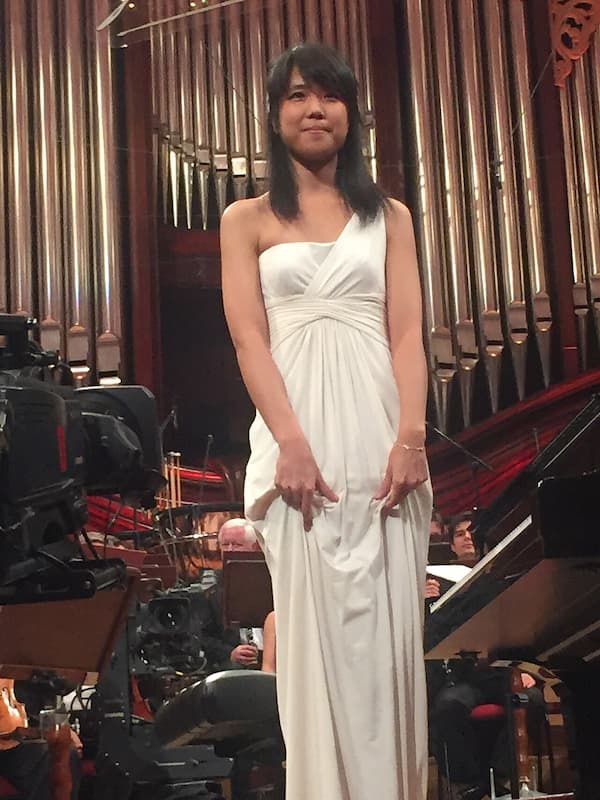Kate Liu first made her name by garnering the third prize at the Chopin Competition 2015, where she was awarded the most 10’s in the finals. With her concert activity previously halted by a hand injury, it is heartening to see Kate Liu return in great form, gradually gaining momentum. Including one of Beethoven’s late piano sonatas and Brahms’ mammoth Piano Sonata No. 3 is certainly an ambitious feat – one that doesn’t fall short of expectations.

The very beginning of Beethoven’s Piano Sonata in A-flat major, Op. 110, immediately beguiles with a liquid and singing tone (also thanks to the sound engineering), captivatingly sanft as Beethoven asked for. In particular, Liu’s thinking in long phrases is befitting of the expansive nature of the first movement. And to the critic who suggested Liu “undermines the magical transitional effect of the unadorned D flats by ignoring the crucial crescendo” at 2:38, there is, in fact, a diminuendo placed before the bar, and the “crucial crescendo” is written after the D-flats. That said, the protracted ritardando at the end can feel somewhat contrived.
Ludwig van Beethoven: Piano Sonata No. 31 in A-flat major, Op. 110 – I. Moderato cantabile molto espressivo (Kate Liu, piano)
The almost grotesque character of the Scherzo, in which Beethoven employed motifs from two folk songs – “Our cat has had kittens” and “I’m draggletailed; you are draggletailed” – is aptly defined. It has the right intensity, hesitations, and wit.
The finale begins with some true pianissimo followed by a sensitively crafted recitative, although the repeated A notes could have yielded even greater yearning and a sense of tragedy. The Klagender Gesang (Song of Lamentation) has effective operatic imitation in both its vocal quality and expressivity. What strikes me is the continuity between sections and Liu’s thoughtful efforts in avoiding sectionalising the music while conferring distinct characters to each of them – the first fugue introduces itself as emerging light in an abyss of absolute darkness, while after the return of arioso (marked Ermattet, klagend; or exhausted, weeping), it regains inner strength in the second fugue. The buildup is carefully planned and executed; the music is led to an unstoppable, euphoric conclusion gloriously captured under Liu’s hands, even though it could’ve been even more unbridled and volcanic.
Beethoven Piano Sonata No. 31 in A-flat major, Op. 110 – III. Adagio ma non troppo – Fuga: Allegro ma non troppo (Kate Liu, piano)

Kate Liu at the International Chopin Piano Competition 2015, Finals © Wikipedia
While both sonatas delve into human vulnerabilities and transcendence, Liu’s reading of Brahms seems to resonate on a deeper level and offers a more assured path to the sublime. Set at a stately pace (she does have an inclination to stretch slow tempi), the first movement is of symphonic scope in its texture and intensity of expression. This is further augmented by a full-bodied sound imbued with orchestral colours. The second movement, also the emotional core of this sonata, is simply sublime – exquisitely voiced and paced, tender, affectionate – eventually growing into one of the most magnificently rapturous expressions in piano literature.
Johannes Brahms: Piano Sonata No. 3 in F minor, Op. 5 – II. Andante espressivo (Kate Liu, piano)
Liu characterises the Scherzo as an enchantingly diabolic, menacing waltz with a potent pulse, forming a stark contrast to the tranquility of the Trio. The fate motif (also with a timpani effect) in the Intermezzo, nevertheless, could have been more ominous with a more judicious use of the sustain pedal.
Johannes Brahms: Piano Sonata No. 3 in F minor, Op. 5 – III. Scherzo: Allegro energico (Kate Liu, piano)
Liu gives a truly colossal account of the finale – this refers not merely to the dynamic level, but also to the overarching architecture, the scale of imagination, and the overwhelming sense of overcoming. As one would’ve expected, the pianism presented here is of astounding virtuosity, surpassing the technical hurdles and contrapuntal intricacies with conviction and, importantly, a sense of abandon. Listen to the ending (especially from 7:32 onwards) – it is just spectacular.
Johannes Brahms: Piano Sonata No. 3 in F minor, Op. 5 – V. Allegro moderato ma rubato (Kate Liu, piano)
This album was released by Orchid Classics on 17 January 2025.
For more of the best in classical music, sign up for our E-Newsletter

